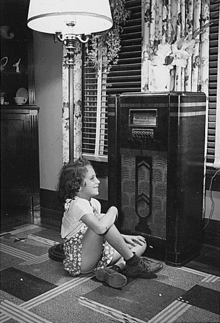
Back مستقبل راديوي Arabic অনাতাঁৰ গ্ৰাহক যন্ত্ৰ Assamese Radio (receptor) AST Радиоалғыс Bashkir Радыёпрыёмнік Byelorussian Радыёпрымач BE-X-OLD Радиоприемник Bulgarian রেডিও রিসিভার Bengali/Bangla Receptor de ràdio Catalan Rádiový přijímač Czech



In radio communications, a radio receiver, also known as a receiver, a wireless, or simply a radio, is an electronic device that receives radio waves and converts the information carried by them to a usable form. It is used with an antenna. The antenna intercepts radio waves (electromagnetic waves of radio frequency) and converts them to tiny alternating currents which are applied to the receiver, and the receiver extracts the desired information. The receiver uses electronic filters to separate the desired radio frequency signal from all the other signals picked up by the antenna, an electronic amplifier to increase the power of the signal for further processing, and finally recovers the desired information through demodulation.
Radio receivers are essential components of all systems that use radio. The information produced by the receiver may be in the form of sound, video (television), or digital data.[1] A radio receiver may be a separate piece of electronic equipment, or an electronic circuit within another device. The most familiar type of radio receiver for most people is a broadcast radio receiver, which reproduces sound transmitted by radio broadcasting stations, historically the first mass-market radio application. A broadcast receiver is commonly called a "radio". However radio receivers are very widely used in other areas of modern technology, in televisions, cell phones, wireless modems, radio clocks and other components of communications, remote control, and wireless networking systems.